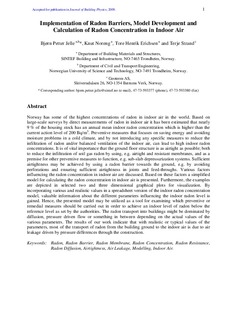| dc.contributor.author | Jelle, Bjørn Petter | |
| dc.contributor.author | Noreng, Knut | |
| dc.contributor.author | Erichsen, Tore Henrik | |
| dc.contributor.author | Strand, Terje | |
| dc.date.accessioned | 2017-09-05T07:18:47Z | |
| dc.date.available | 2017-09-05T07:18:47Z | |
| dc.date.created | 2010-03-29T10:03:57Z | |
| dc.date.issued | 2011 | |
| dc.identifier.citation | Journal of Building Physics. 2011, 34 (3), 195-222. | nb_NO |
| dc.identifier.issn | 1744-2591 | |
| dc.identifier.uri | http://hdl.handle.net/11250/2453120 | |
| dc.description.abstract | Norway has some of the highest concentrations of radon in indoor air in the world. Based on large-scale surveys by direct measurements of radon in indoor air it has been estimated that nearly 9 % of the housing stock has an annual mean indoor radon concentration which is higher than the current action level of 200 Bq/m 3 . Preventive measures that focuses on saving energy and avoiding moisture problems in a cold climate, and by not introducing any specific measures to reduce the infiltration of radon and/or balanced ventilation of the indoor air, can lead to high indoor radon concentrations. It is of vital importance that the ground floor structure is as airtight as possible; both to reduce the infiltration of soil gas radon by using, e.g. airtight and resistant membranes, and as a premise for other preventive measures to function, e.g. sub-slab depressurization systems. Sufficient airtightness may be achieved by using a radon barrier towards the ground, e.g. by avoiding perforations and ensuring sufficient airtightness in joints and feed-throughs. Various factors influencing the radon concentration in indoor air are discussed. Based on these factors a simplified model for calculating the radon concentration in indoor air is presented. Furthermore, the examples are depicted in selected two and three dimensional graphical plots for visualization. By incorporating various and realistic values in a spreadsheet version of the indoor radon concentration model, valuable information about the different parameters influencing the indoor radon level is gained. Hence, the presented model may be utilized as a tool for examining which preventive or remedial measures should be carried out in order to achieve an indoor level of radon below the reference level as set by the authorities. The radon transport into buildings might be dominated by diffusion, pressure driven flow or something in between depending on the actual values of the various parameters. The results of our work indicate that with realistic or typical values of the parameters, most of the transport of radon from the building ground to the indoor air is due to air leakage driven by pressure differences through the construction. | nb_NO |
| dc.language.iso | eng | nb_NO |
| dc.publisher | Sage | nb_NO |
| dc.relation.uri | http://jen.sagepub.com/content/early/2010/03/30/1744259109358285.full.pdf+html | |
| dc.subject | Radon | nb_NO |
| dc.subject | Radon barrier | nb_NO |
| dc.subject | Radon membrane | nb_NO |
| dc.subject | Radon concentration | nb_NO |
| dc.subject | Radon resistance | nb_NO |
| dc.subject | Radon diffusion | nb_NO |
| dc.subject | Airtightness | nb_NO |
| dc.subject | Air leakage | nb_NO |
| dc.subject | Modeling | nb_NO |
| dc.subject | Indoor air | nb_NO |
| dc.title | Implementation of Radon Barriers, Model Development and Calculation of Radon Concentration in Indoor Air | nb_NO |
| dc.type | Journal article | nb_NO |
| dc.type | Peer reviewed | nb_NO |
| dc.description.version | acceptedVersion | nb_NO |
| dc.rights.holder | This is the authors' accepted and refereed manuscript to the article. The final publication is available at http://www.dx.doi.org/10.1177/1744259109358285 | nb_NO |
| dc.subject.nsi | VDP::Technology: 500 | nb_NO |
| dc.source.pagenumber | 195-222 | nb_NO |
| dc.source.volume | 34 | nb_NO |
| dc.source.journal | Journal of Building Physics | nb_NO |
| dc.source.issue | 3 | nb_NO |
| dc.identifier.doi | 10.1177/1744259109358285 | |
| dc.identifier.cristin | 342070 | |
| cristin.unitcode | 7401,30,40,0 | |
| cristin.unitcode | 7401,30,50,0 | |
| cristin.unitname | Arkitektur, byggematerialer og konstruksjoner | |
| cristin.unitname | Kunnskapsformidling | |
| cristin.ispublished | true | |
| cristin.fulltext | original | |
| cristin.fulltext | postprint | |
| cristin.qualitycode | 2 | |

